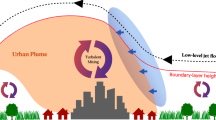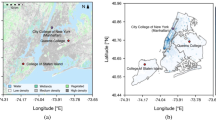Abstract
The formation mechanism of the nocturnal urban boundary layer (UBL), especially in the winter nighttime, was investigated based on the extensive field observations conducted during November 1984 in Sapporo, Japan. A strong, elevated inversion formed over the Sapporo urban area and the inversion base height was approximately twice the average building height. Velocity fluctuations Σ u, Σw and Reynolds stress % MathType!MTEF!2!1!+-% feaafeart1ev1aaatCvAUfeBSjuyZL2yd9gzLbvyNv2CaerbuLwBLn% hiov2DGi1BTfMBaeXatLxBI9gBaerbd9wDYLwzYbItLDharqqtubsr% 4rNCHbGeaGqiVu0Je9sqqrpepC0xbbL8F4rqqrFfpeea0xe9Lq-Jc9% vqaqpepm0xbba9pwe9Q8fs0-yqaqpepae9pg0FirpepeKkFr0xfr-x% fr-xb9adbaqaaeGaciGaaiaabeqaamaabaabaaGcbaWaa0aaaeaaca% WG1bWaaWbaaSqabeaacaaIXaaaaGGaaOGae8hiaaIaam4DamaaCaaa% leqabaGaaGymaaaaaaaaaa!3A9C!\[\overline {u^1 w^1 } \] had nearly uniform profiles within the nocturnal UBL and decreased with height above the UBL. On the other hand, temperature fluctuations Σ t , and heat fluxes % MathType!MTEF!2!1!+-% feaafeart1ev1aaatCvAUfeBSjuyZL2yd9gzLbvyNv2CaerbuLwBLn% hiov2DGi1BTfMBaeXatLxBI9gBaerbd9wDYLwzYbItLDharqqtubsr% 4rNCHbGeaGqiVu0Je9sqqrpepC0xbbL8F4rqqrFfpeea0xe9Lq-Jc9% vqaqpepm0xbba9pwe9Q8fs0-yqaqpepae9pg0FirpepeKkFr0xfr-x% fr-xb9adbaqaaeGaciGaaiaabeqaamaabaabaaGcbaWaa0aaaeaaca% WG1bWaaWbaaSqabeaacaaIXaaaaGGaaOGae8hiaaIaeqiUde3aaWba% aSqabeaacaaIXaaaaaaaaaa!3B56!\[\overline {u^1 \theta ^1 } \] and % MathType!MTEF!2!1!+-% feaafeart1ev1aaatCvAUfeBSjuyZL2yd9gzLbvyNv2CaerbuLwBLn% hiov2DGi1BTfMBaeXatLxBI9gBaerbd9wDYLwzYbItLDharqqtubsr% 4rNCHbGeaGqiVu0Je9sqqrpepC0xbbL8F4rqqrFfpeea0xe9Lq-Jc9% vqaqpepm0xbba9pwe9Q8fs0-yqaqpepae9pg0FirpepeKkFr0xfr-x% fr-xb9adbaqaaeGaciGaaiaabeqaamaabaabaaGcbaWaa0aaaeaaca% WG3bWaaWbaaSqabeaacaaIXaaaaGGaaOGae8hiaaIaeqiUde3aaWba% aSqabeaacaaIXaaaaaaaaaa!3B58!\[\overline {w^1 \theta ^1 } \] had peaks at the inversion base and small values within the nocturnal UBL. The turbulent kinetic energy budget showed that the turbulent transport term and shear generation from urban canopy elements are important in the nocturnal UBL development; the role of the buoyancy term is small. The turbulence data analysis and application of a simple advective model showed that the mechanism of UBL formation may be controlled by the downward transport of sensible heat from the elevated inversion caused by mechanically-generated turbulence.
Similar content being viewed by others
Abbreviations
- g :
-
accelaration due to gravity, m s-2
- k :
-
turbulent kinetic energy, m2 s-1
- K m :
-
eddy viscosity, m2 s-1
- L :
-
Monin-Obukhov lenght, m
- p :
-
pressure, Kg m-2
- U, V, W :
-
mean wind speed in the downwind, crosswind, and vertical directions, respectively, m s-1
- u 1, w 1 :
-
wind speed fluctuation in the downwind and vertical direction, respectively, m s-1
- u 1 :
-
friction velocity, m s-1
- % MathType!MTEF!2!1!+-% feaafeart1ev1aaatCvAUfeBSjuyZL2yd9gzLbvyNv2CaerbuLwBLn% hiov2DGi1BTfMBaeXatLxBI9gBaerbd9wDYLwzYbItLDharqqtubsr% 4rNCHbGeaGqiVu0Je9sqqrpepC0xbbL8F4rqqrFfpeea0xe9Lq-Jc9% vqaqpepm0xbba9pwe9Q8fs0-yqaqpepae9pg0FirpepeKkFr0xfr-x% fr-xb9adbaqaaeGaciGaaiaabeqaamaabaabaaGcbaWaa0aaaeaaca% WG1bWaaWbaaSqabeaacaaIXaaaaGGaaOGae8hiaaIaam4DamaaCaaa% leqabaGaaGymaaaaaaaaaa!3A9C!\[\overline {u^1 w^1 } \]:
-
momentum flux, m2s-2
- % MathType!MTEF!2!1!+-% feaafeart1ev1aaatCvAUfeBSjuyZL2yd9gzLbvyNv2CaerbuLwBLn% hiov2DGi1BTfMBaeXatLxBI9gBaerbd9wDYLwzYbItLDharqqtubsr% 4rNCHbGeaGqiVu0Je9sqqrpepC0xbbL8F4rqqrFfpeea0xe9Lq-Jc9% vqaqpepm0xbba9pwe9Q8fs0-yqaqpepae9pg0FirpepeKkFr0xfr-x% fr-xb9adbaqaaeGaciGaaiaabeqaamaabaabaaGcbaWaa0aaaeaaca% WG1bWaaWbaaSqabeaacaaIXaaaaGGaaOGae8hiaaIaam4DamaaCaaa% leqabaGaaGymaaaaaaaaaa!3A9C!\[\overline {u^1 \theta^1 } \]:
-
sensible heat flux, m2s-1°C
- WD :
-
wind direction, deg
- WS :
-
wind speed, m s-1
- z :
-
altitude, m
- Z h :
-
inversion base height, m
- Z j :
-
wind maximum height, m
- Z t :
-
inversion top height, m
- ΔT u-r :
-
heat island intensity, °C
- γ :
-
temperature lapse rate at rural site, °C m-1
- ε :
-
energy dissipation rate, m2s-3
- θ 1 :
-
Potential temperature fluctuation, °C
- θ * :
-
scaling temperature, (=-% MathType!MTEF!2!1!+-% feaafeart1ev1aaatCvAUfeBSjuyZL2yd9gzLbvyNv2CaerbuLwBLn% hiov2DGi1BTfMBaeXatLxBI9gBaerbd9wDYLwzYbItLDharqqtubsr% 4rNCHbGeaGqiVu0Je9sqqrpepC0xbbL8F4rqqrFfpeea0xe9Lq-Jc9% vqaqpepm0xbba9pwe9Q8fs0-yqaqpepae9pg0FirpepeKkFr0xfr-x% fr-xb9adbaqaaeGaciGaaiaabeqaamaabaabaaGcbaWaa0aaaeaaca% WG1bWaaWbaaSqabeaacaaIXaaaaGGaaOGae8hiaaIaeqiUde3aaWba% aSqabeaacaaIXaaaaaaaaaa!3B56!\[\overline {u^1 \theta ^1 } \]/u*) °C
- θ :
-
mean potential temperature fluctuation, K
- ρ :
-
density of air, Kgm-3
- K :
-
von Kármán constant (=0.4)
- σu, σv, σw :
-
standard deviation of wind speed in the downwind, crosswind, and vertical directions, respectively, m s-1
- σ :
-
standard diviation of temperature, °C
References
Bornstein, R. D.: 1968, ‘Observations of Urban Heat Island Effect in New York City’, J. Appl. Meteorol. 7, 575–582.
Busch, N. E.: 1973, ‘On the Mechanics of Atmospheric Turbulence’, in D. A. Haugen (ed.), Workshop on Micrometeorology, American Meteorol. Soc., pp. 1–65.
Clarke, J. F.: 1969, ‘Nocturnal Urban Boundary Layer over Cincinnati, Ohio’, Mon. Wea. Rev. 97, 582–589.
Clarke, J. F., Ching, J. K. S., and Godowitch, J. M.: 1982, ‘An Experimental Study of Turbulence in an Urban Environment’, EPA 600/3-82-062, 1
Duckworth, F. S. and Sandberg, J. S.: 1954, ‘The Effect of Cities upon Horizontal and Vertical Temperature Gradients’, Bull. Am. Meteorol. Soc. 35, 198–209.
Garstang, M., Tyson, P. D., and Emmitt, G. D.: 1975, ‘The Structure of Heat Islands’, Rev. of Geophysics and Space Physics 13, 139–165.
Godowitch, J. M., Ching, J. K. S., and Clarke, J. F.: 1985, ‘Evolution of the Nocturnal Inversion Layer at the Urban and Nonurban Location’, J. Clim. Appl. Meteorol. 24, 791–804.
Hildebrand, P. H. and Ackerman, B.: 1984, ‘Urban Effects on the Convective Boundary Layer’, J. Atmos. Sci. 41, 76–91.
Japan Environment Agency: 1987, Quality of the Environment in Japan 1986.
Kaimal, J. C., Wyngaard, J. C., Izumi, Y., and Coté, O. R.: 1972, ‘Spectral Characteristics of Surface Layer Turbulence’, Quart. J. R. Meteorol. Soc., 98, 563–589.
Ogawa, Y. and Ohara, T.: 1982, ‘Observation of the Turbulent Structure in the Planetary Boundary Layer with a Kytoon-mounted Ultarsonic Anemometer System’, Boundary-Layer Meteorol. 22, 123–131.
Ogawa, Y., Ohara, T., Wakamatsu, S., Diosey, P. G., and Uno, I.: 1986, ‘Observation of Lake Breeze Penetration and Subsequent Development of the Thermal Internal Boundary Layer for the Nanticoke II Shortline Diffusion Experiment’, Boundary-Layer Meteorol. 35, 207–230.
Oke, T. R.: 1974, ‘Review of Urban Climatology 1968–1973’, WMO Tech. Note No. 134.
Oke, T. R.: 1979, ‘Review of Urban Climatology 1973–1976’, WMO Tech. Note No. 169.
Oke, T. R.: 1982, ‘The Energetic Basis of the Urban Heat Island’, Quart. J. Royal Meteorol. Soc. 108, 1–24.
Oke, T. R. and East, C.: 1971, ‘The Urban Boundary Layer in Montreal’, Boundary-Layer Meteorol. 1, 411–437.
Panofsky, H. A. and Dutton, J. A.: 1984, Atmospheric Turbulence: Models and Methods for Engineering Applications, John Wiley & Sons, New York.
Summers, P. W.: 1965, An Urban Heat Island Model; Its Role in Air Pollution Problems, with Application to Montreal, Ph.D. thesis, Dpt. Meteorol., McGill, Montreal, Canada.
Uno, I., Ueda, H. and Wakamatsu, S.: 1988, Numerical Modeling of the Nocturnal Urban Boundary Layer, in preparation.
Tamiya, H. and Ohyama, H.: 1981, ‘Nocturnal Heat Island of Small Town, its Manifestation and Mechanism’, Geographical Rev. of Japan 54, 1–21, (in Japanese with English abstract).
Author information
Authors and Affiliations
Rights and permissions
About this article
Cite this article
Uno, I., Wakamatsu, S., Ueda, H. et al. An observational study of the structure of the nocturnal urban boundary layer. Boundary-Layer Meteorol 45, 59–82 (1988). https://doi.org/10.1007/BF00120815
Revised:
Issue Date:
DOI: https://doi.org/10.1007/BF00120815




